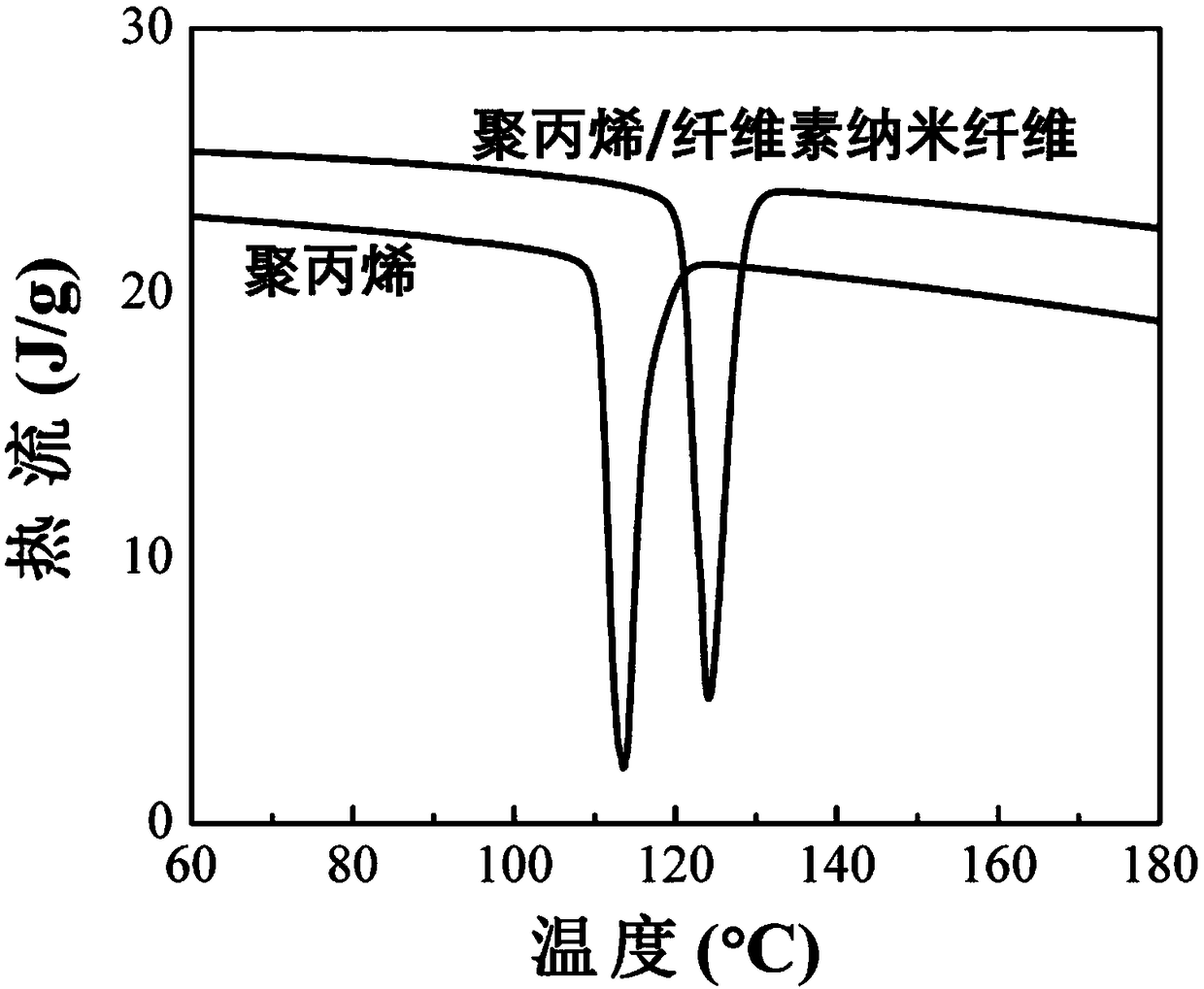Nano cellulose reinforced polypropylene foam material and preparation method thereof
A technology of nanocellulose and foaming materials, applied in the field of nanocellulose reinforced polypropylene foaming materials and its preparation, polypropylene materials and its preparation, can solve the problems of easy formation of voids and defects, poor mechanical properties of composite materials, distribution Uniformity and other issues, to achieve the effect of promoting crystallization performance, improving foaming ability, and high modulus
- Summary
- Abstract
- Description
- Claims
- Application Information
AI Technical Summary
Problems solved by technology
Method used
Image
Examples
Embodiment 1
[0045] (1) Dilute the bleached kraft pulp containing cellulose to a 2wt% slurry with distilled water, then use a ball mill to disperse the slurry at 30°C and a feed rate of 750ml / min to obtain a nanocellulose slurry.
[0046] (2) 40 parts of nanocellulose slurry, 0.2 part of maleic anhydride grafted polypropylene, and 97.8 parts of polypropylene with a number average molecular weight of 250,000 were melted together in a twin-screw extruder with a nanocellulose mass content of 5%. mixed to obtain a polypropylene / cellulose composite material with a nanocellulose content of 1%.
[0047] (3) The composite material is placed in the first-stage twin-screw extruder, the melting temperature is 170-230 ° C, the screw speed is 15 r / min, and 9.78 parts of nitrogen (1% of the polypropylene mass) is extruded The metering pump at the gas injection port on the machine feeds into the screw, mixes evenly, and obtains a single-phase polymer / gas melt.
[0048] (4) Import the single-phase polyme...
Embodiment 2
[0051] (1) Dilute the bleached kraft pulp containing cellulose to a 2wt% slurry with distilled water, then use a ball mill to disperse the slurry at 40°C and a feed rate of 700ml / min to obtain a nanocellulose slurry.
[0052] (2) 97.8 parts of 97.8 parts of polypropylene with 350,000 number average molecular weights of 40 parts of nanocellulose slurry, 0.2 parts of maleic anhydride grafted polypropylene, and 350,000 number average molecular weights were melted in a twin-screw extruder mixed to obtain a polypropylene / cellulose composite material with a nanocellulose content of 1%.
[0053] (3) Put the composite material in the first-stage twin-screw extruder, the melting temperature is 170-230°C, the screw speed is 20r / min, and at the same time, 1.956 parts of nitrogen gas is pumped from the gas injection port on the extruder Input into the screw, mix evenly to obtain a single-phase polymer / gas melt.
[0054] (4) Import the single-phase polymer / gas melt into the second-stage s...
Embodiment 3
[0057] (1) Dilute the bleached kraft pulp containing cellulose to a 2wt% slurry with distilled water, then use a ball mill to disperse the slurry at 40°C and a feed rate of 700ml / min to obtain a nanocellulose slurry.
[0058] (2) 97.8 parts of 450,000 polypropylenes with a nanocellulose mass content of 40 parts of nanocellulose slurry, 0.2 parts of maleic anhydride grafted polypropylene and number average molecular weight of 450,000 were melted in a twin-screw extruder mixed to obtain a polypropylene / cellulose composite material with a nanocellulose content of 1%.
[0059] (3) Put the composite material in the first-stage twin-screw extruder, the melting temperature is 170-230°C, the screw speed is 25r / min, and at the same time, 2.934 parts of nitrogen are fed into the screw by the gas injection port metering pump on the extruder Inside, mix uniformly to obtain a single-phase polymer / gas melt.
[0060] (4) Introduce the single-phase polymer / gas melt into the second-stage sing...
PUM
| Property | Measurement | Unit |
|---|---|---|
| Melting temperature | aaaaa | aaaaa |
Abstract
Description
Claims
Application Information
 Login to View More
Login to View More - R&D
- Intellectual Property
- Life Sciences
- Materials
- Tech Scout
- Unparalleled Data Quality
- Higher Quality Content
- 60% Fewer Hallucinations
Browse by: Latest US Patents, China's latest patents, Technical Efficacy Thesaurus, Application Domain, Technology Topic, Popular Technical Reports.
© 2025 PatSnap. All rights reserved.Legal|Privacy policy|Modern Slavery Act Transparency Statement|Sitemap|About US| Contact US: help@patsnap.com


